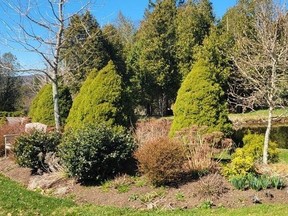Duncan Kelbaugh: Cleaning up the many garden beds

Article content
Today I’d like to show you one part of the most enjoyable but expansive projects I’ve been busying myself with over the last month or so, with every hour I can get away from our garden centre, now fully open for spring. It’s the annual spring cleanup of our many (Betty feels it might be too many) garden beds, a job I could, and maybe should, have done last fall, if life wasn’t just so darn busy.
It’s OK that this job was left until spring, but the clock is ticking fast on that OK status. Perennial weeds are up an inch or two, and annual weeds just germinating. The good guys are making similar progress. In this bed for instance, the daffodils are six inches tall with fat buds ready to open, salvia and sedum tips one to two inches, and I happily saw small pink tips opening on the hundreds of big flower buds on the magnolia. That’s all very exciting, but I really want to get last year’s perennial tops off in the next week, while the new tips are still low, prune any shrubs that are getting too large for their spots in the bed, and pop out the dandelions and other perennial weeds while they are still cute and little. Tick tock, spring’s clock waits for no one, including the busy, well-intentioned but tardy gardener!
In person, the difference before and after is quite distinct, as you walk up close and around the bed admiring your work. From your current perspective, in a 2D photo, the difference will be much more subtle. I liken it to a picture out of focus (with weeds, grass, dead tops and shaggy haircuts) that you, the gardener, brings into sharp focus with your edger, shears, pruners and hoe.

First I’ll mention the background of the bed containing two more of my passions, trout pond on the right, which takes almost none of my time but brings great pleasure, and pickleball court on the left, which vies jealously for my gardening time. Now to the foreground. Let’s peruse the bed, from right to left, and I’ll describe the things I worked on (and the ones that didn’t need it) to make this subtle but pleasing facelift. I’ll note that the time stamps on the two photos from yesterday’s work were only 1.5 hours apart, illustrating that timely maintenance goes fairly quickly. The same job one month from now would have taken easily twice the time, and been a bit aggravating rather than so pleasant and easy as this was.
The big deciduous tree at the right end is a pink star magnolia, which I no doubt will not be able to resist showing you in a couple weeks when it is in full bloom. I have nursed and shaped this tree from a four-foot stunted, crooked, unshapely reject from the garden centre six or eight years ago into this full, healthy, evenly branched 10 foot beauty. After letting it recover from being heavily pot-bound for many years by planting it in full sun in a deep, fertile, well-drained topsoil bed, it began to gradually put out more leaves and longer stems each year. I began pruning, holding back the longer branches while those on the short sides grew out and filled in the canopy. I also gradually removed lower limbs until the first one is now almost four feet off the ground. That gives it a more attractive tree form, allows me to work under it on the other plants, and lets in more light for those smaller neighbours.
The light yellow mass to the right of the magnolia trunk is a golden lamium groundcover perennial. That whole class of perennials spreads gradually into masses that become too wide, either bumping into other plants or walkways, and often developing dead spots and flaws. I simply went around the outer edge of this one ripping out handfuls of rooted shoots until the clump was back to a reasonable size for its position in the bed, and not filling the edge or spilling onto the lawn. This process can generate transplants if you need any to start clumps elsewhere. If that’s the plan, dig rooted clumps up with a trowel to make viable transplants. Remember when planting new beds to plant three or more of a kind in groupings (mass planting) for greater visual impact than mere individuals.
Generally speaking, I dug out any perennial weeds now greening up, especially dandelions, by the roots, before they get bigger and difficult to remove. Last year’s perennial tops were cut or snapped off just above the new shoots for an immediate aesthetic improvement. It allows more room for those new shoots to develop and air to circulate which can lessen fungal disease. That’s particularly important for peonies, as Botrytis can be a significant rot-inducing disease for them, that can reside in last year’s foliage, then infect the new stems with a black rot. You probably can’t see it, but the heavy duty peony ring is already in place. That’s because of my final realization after years of forgetting to get the stored rings out and in place before the new stems got too tall that I could simply leave them in place year-round. That has been one of my Einstein moments. They are out of sight all summer and fall under the foliage, then protect the vulnerable crowns and young shoots all winter and spring, and remind you where your peonies are when they are busy hibernating. Brilliant!
As I crept across the bed on my well padded knees removing perennial weeds, I of course was raking up fall leaves and dead annuals from last year, then lightly cultivating and smoothing the surface, to give it that refined look. The final such refinement was at the edge. It had been cut late last summer with the edger, so that step wasn’t necessary. I just hoed out the debris, then cut the grass closely with a sharp pair of hedge shears. Clean edges are as important as the frame of a painting.
Lastly, pruning of the shrubs. To get the whole property covered in the next week or two max, I am only doing critical pruning for now. The magnolia will wait till after it blooms, as I cherish every flower bud it has. The massive Alberta spruces are self-pruning, I rarely touch them, as shearing leaves marks, and you just can’t go very deep, or you would remove all the buds. Plant them with three or four feet to neighbouring plants or walls, and you can sit back and watch them for 20 years or so. The pruning I did do yesterday was to the one barberry in the middle foreground, and the two blue hollies to its left. Being in the foreground, it is important to keep them relatively compact for good perspective, and to allow space for colourful annuals and perennials. I used my hand pruners, and removed longer branches cut back well inside the canopy where the cuts can’t be seen, thinning, shrinking and shaping them until they were a happy size and shape.
One and a half hours of pleasant easy work in the afternoon sun took that bed from a fuzzy view of a shaggy garden to a clear winner, the very definition of “All Good”…
Duncan Kelbaugh is the owner of Brunswick Nurseries Garden Centre in Quispamsis.












Postmedia is committed to maintaining a lively but civil forum for discussion. Please keep comments relevant and respectful. Comments may take up to an hour to appear on the site. You will receive an email if there is a reply to your comment, an update to a thread you follow or if a user you follow comments. Visit our Community Guidelines for more information.